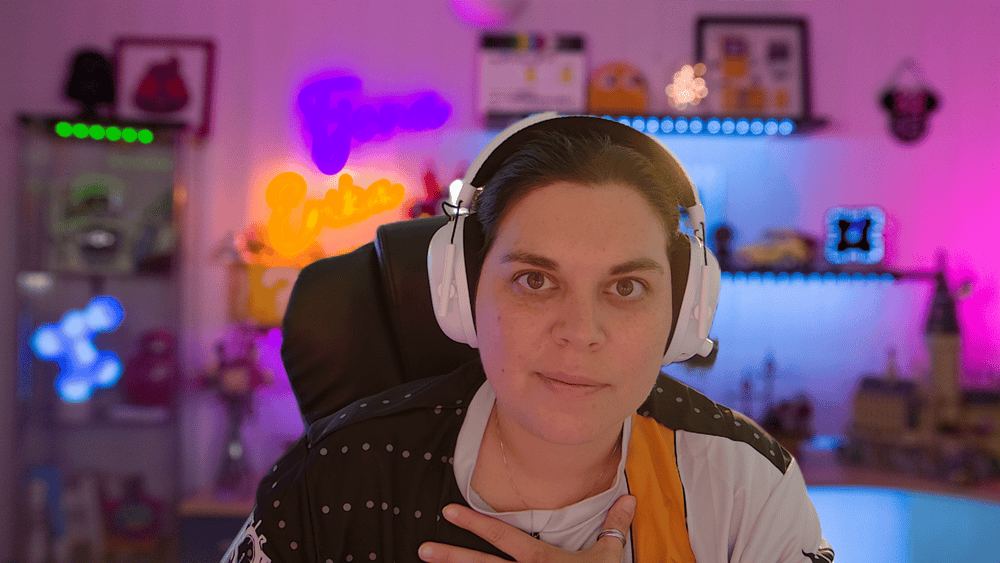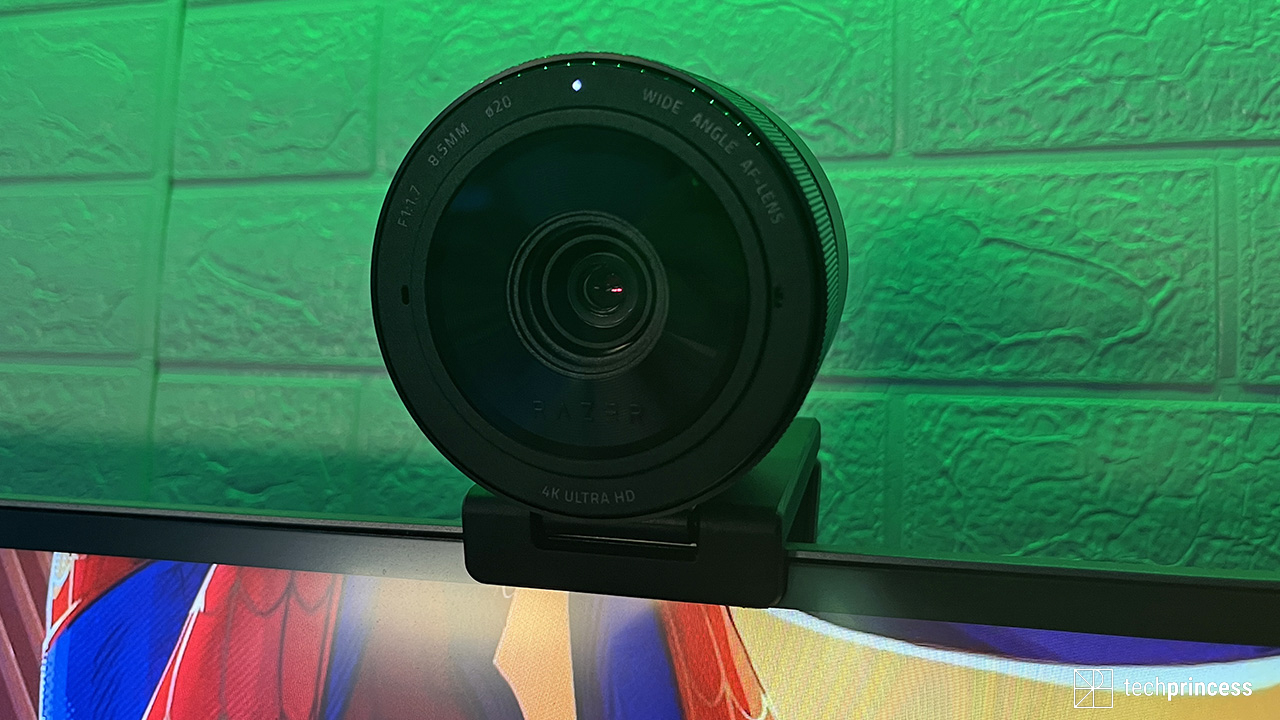Although yes, technically the Razer Kiyo Pro Ultra it’s a webcam.
Not just any though. The Californian company has transformed it into a very high quality product, which doesn’t have much to envy of contemporary cameras. In fact, on board we find an above-average sensor and a rather efficient, albeit still imperfect, focusing system.
However, the price – we anticipate it immediately – is demanding: 349 €.
Design and construction

The Razer Kiyo Pro Ultra isn’t small, or even light.
His 393 grams, and a thickness that makes it look like a mirrorless lens, make it not very suitable for transport and certainly not very discreet once positioned on your monitor or on a tripod. In fact, both solutions are made possible by the presence of the thread on the lower part of the base and by that of a convenient support which, among other things, allows you to recline the Kiyo and rotate it on its axisso as to find the position that best suits your needs.
To characterize it we also find a ring, which allows you to physically close the shutter to offer you all the privacy you need. Plus, it’s in the package a lens cap which adds a further level of protection and which can also be useful for storing the webcam avoiding any scratches on the lens.
They are not missing a small front LED, which helps you understand when the webcam is in use, e a USB-C input to connect it to the computer.
An important detail: the cable is USB-C/USB-A. What does it mean? That with any laptop you may need an adapter given the prevalence of USB-C inputs on laptops. However, the dimensions make it more suitable for Desktop PCs, where USB-A inputs are never lacking.
We are therefore not faced with a defect but with a very precise and, in our opinion, very sensible strategic choice.
Buy it with Mediaworld below cost, find out more!
Razer Kiyo Pro Ultra review: How does it work?

By god.
We could thus dismiss this question because, after using it for days on end, we can say with a large degree of certainty that it’s the best webcam we’ve ever had in our hands.
However, it would not be fair to reduce everything to two words. Also because Razer has really drawn on all of his know-how to give life to this product.
Let’s start with the numbers:
- the resolution is 4K (3.840×2.160 pixel);
- the sensor is a 1/1.2-inch Sony Starvis 2 Ultra con pixel da 2,9 µm;
- the opening is F/1.7;
- the field of view is 82°.
Confused?
All these numbers mean that, first of all, you have the opportunity to use a maximum resolution of 4K at 30 fps; you can go up to 60 fps going down to FullHD. This means that you can opt for greater fluidity at the expense of resolution (which in any case remains excellent and more than suitable for any type of use) or sacrifice a few fps for greater detail.
Considering that most of us are in front of a webcam talking know that 30 fps is more than enough.
Don’t you need very high resolutions? You can go down to 720p, 480p or even 360p.
 An example of the image quality achievable with the Razer Kiyo Pro Ultra in a fairly dark environment
An example of the image quality achievable with the Razer Kiyo Pro Ultra in a fairly dark environment
Compared to the competition Razer Kiyo Ultra Pro captures much more light.
We did a little experiment, i.e. turned off all the lights in the living room and left only one colored light on on the desk. Any other webcam would have had difficulty and some noise would have appeared, this one wasn’t: the image was perfect and the effect was the desired one, i.e. a dark room but with RGB lights, like a real streamer.
The other obvious plus is represented by thebokeh effect, i.e. from the natural blur that separates the subject from the background. The result is very pleasant and, contrary to other competitors, it is not obtained with software tricks.
Also autofocus isn’t bad at all. It is not particularly fast but it is very precise and you can decide whether to keep it automatic or use it manually, whether to give priority or not to the flight and whether to take advantage of passive or responsive tracking.
Everything goes through Razer Synapse
As per Razer tradition, all settings are collected within Synapse 3the software of the American company.
First of all, you can activate the preview and see the result in real time, with the current parameters indicated below. On the side you will find instead three tabs: Camera, Processing, Image.
Camera it allows to manage autofocus, exposure (Auto or Manual) e zoom; know though that the zoom, which reaches to 4x, is not available by selecting 4K or 1440p resolution and enabling Lens Distorsion Compensation, ie the compensation of the distortion of the lens. Either disable the LDC or go down to 1080p.

In Processing find the resolution the quality of the MJPEG file, the activation of theHDR (with two modes: Dark Room or Bright Room), distortion compensation and low light compensation and finally dynamic noise reduction.
He tab Image finally has brightness, contrast, saturation, white balance and a number of presets; from here you can also activate theanti-flickering – at 50 or 60 Hz -, insert the Watermark and choose to reverse the image.
There is essentially nothing you can’t control via Razer Synapse for adapt the webcam to your needs.
Who is it suitable for?

We’ve been using the Razer Kiyo Pro Ultra for a few weeks now and we’re in love with it.
We used her for Twitch lives, we used her for video calls, we tried to record some videos just with her and good old OBS. In all these situations she performed very well: the quality is very high, the blur is very pleasant, the autofocus is precise and it is also useful for showing objects to our interlocutors and the software allows you to adjust the parameters easilywith a lot of explanations that can help even inexperienced users.
Where did it not impress us? Well, on the audio front. It’s not bad but it is clear that a €349 webcam must be combined with an external microphone. Also because if you are willing to spend this amount it is because you need particularly high quality. The one you need to streamers or content creators.
It doesn’t mean that you can’t buy it for webcalls with relatives or those with colleagues and customers, but be aware that, also considering the limitations of videoconferencing software, this is not how you will take full advantage of the Razer Kiyo Pro Ultra.
The Razer Kiyo Pro Ultra review: conclusions
We have partially spoiled the conclusions but it was impossible not to.
Razer Kiyo Pro Ultra is a product… well, “ultra”.
It is superior to the competition and other webcams from the Kiyo family. It was born to be a convincing alternative to a camera, which however often requires more cumbersome operations and a nice tripod to be positioned and used.
If you want the best possible quality, the maximum that the market can offer you, this is the perfect solution.















Leave a Reply
View Comments